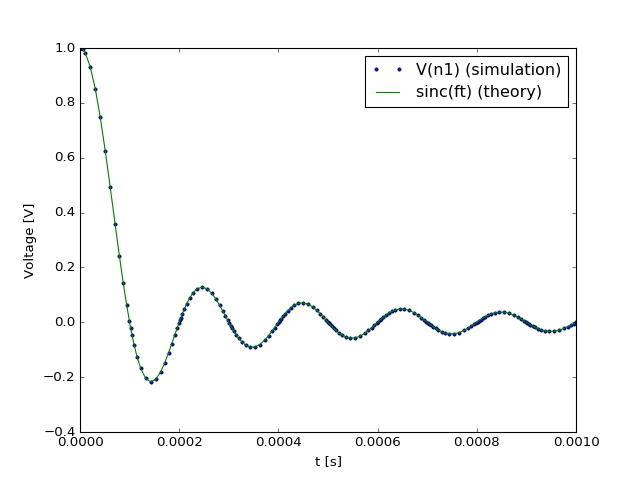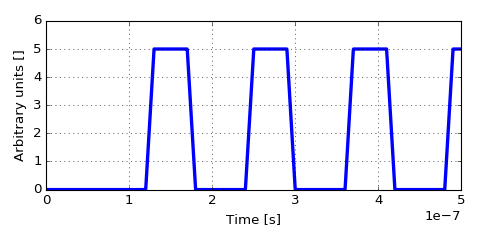ahkab.time_functions¶
This module contains several basic time functions.
The classes that are found in module are useful to provide a time-varying characteristic to independent sources.
Notice that the time functions are not restricted to those provided here, the user is welcome to provide his own. Implementing a custom time function is easy and common practice, as long as you are interfacing to the simulator through Python. Please see the dedicated section Defining custom time functions below.
Classes defined in this module¶
pulse(v1, v2, td, tr, pw, tf, per) |
Square wave aka pulse function |
pwl(x, y[, repeat, repeat_time, td]) |
Piece-Wise Linear (PWL) waveform |
sin(vo, va, freq[, td, theta, phi]) |
Sine wave |
exp(v1, v2, td1, tau1, td2, tau2) |
Exponential wave |
sffm(vo, va, fc, mdi, fs, td) |
Single-Frequency FM (SFFM) waveform |
am(sa, fc, fm, oc, td) |
Amplitude Modulated (AM) waveform |
Supplying a time function to an independent source¶
Providing a time-dependent characteristic to an independent source is very simple and probably best explained with an example.
Let’s say we wish to define a sinusoidal voltage source with no offset, amplitude 5V and 1kHz frequency.
It is done in two steps:
first we define the time function with the built-in class
ahkab.time_functions.sin:sin1k = time_functions.sin(vo=0, va=5, freq=1e3)
Then we define the voltage source and we assign the time function to it:
cir.add_vsource('V1', 'n1', cir.gnd, 1, function=mys)
In the example above, the sine wave is assigned to a voltage source 'V1',
that gets added to a circuit cir (not shown).
Defining custom time functions¶
Defining a custom time function is easy, all you need is either:
- A function that takes a
float(the time) and returns the function value, - An instance with a
__call__(self, time)method. This solution allows having internal parameters, typically set through the constructor.
In both cases, in time-based simulations, the simulator will call the object at
every time step, supplying a single parameter, the simulation time (time in
the following, of type float).
In turn, the simulator expects to receive as return value a float,
corresponding to the value of the time-dependent function at the time specified
by the time variable.
If the time-dependent function is used to define the characteristics of a
voltage source (VSource), its return value has to be expressed in Volt.
In the case of a current source (ISource), the return value is to be
expressed in Ampere.
The standard notation applies.
As an example, we’ll define a custom time-dependent voltage source, having a \(\mathrm{sinc}(ft)\) characteristic. In this example, \(f\) has a value of 10kHz.
First we define the time function, in this case we’ll do that through the Python
lambda construct.
mys = lambda t: 1 if not t else math.sin(math.pi*1e4*t)/(math.pi*1e4*t)
Then, we define the circuit – a very simple one in this case – and assign our
mys function to V1. In the following circuit, we simply apply the
voltage from V1 to a resistor R1.
import ahkab
cir = ahkab.Circuit('Test custom time functions')
cir.add_resistor('R1', 'n1', cir.gnd, 1e3)
cir.add_vsource('V1', 'n1', cir.gnd, 1, function=mys)
tr = ahkab.new_tran(0, 1e-3, 1e-5, x0=None)
r = ahkab.run(cir, tr)['tran']
Plotting Vn1 and the expected result (\(\mathrm{sinc}(ft)\)) we
get:
(Source code, png, hires.png, pdf)

Module reference¶
-
class
am(sa, fc, fm, oc, td)[source]¶ Amplitude Modulated (AM) waveform
Mathematically, it is described by the equations:
- \(0 \le t \le t_D\):
\[f(t) = O\]- \(t > t_D\)
\[f(t) = SA \cdot \left[OC + \sin \left[2\pi f_m (t - t_D) \right] \right] \cdot \sin \left[2 \pi f_c (t - t_D) \right]\]Parameters:
- sa : float
- Signal amplitude in Volt or Ampere.
- fc : float
- Carrier frequency in Hertz.
- fm : float
- Modulation frequency in Hertz.
- oc : float
- Offset constant, setting the absolute magnitude of the modulation.
- td : float
- Time delay before the signal begins, in seconds.
-
class
exp(v1, v2, td1, tau1, td2, tau2)[source]¶ Exponential wave
Mathematically, it is described by the equations:
- \(0 \le t < TD1\):
\[f(t) = V1\]- \(TD1 < t < TD2\)
\[f(t) = V1+(V2-V1) \cdot \left[1-\exp \left(-\frac{t-TD1}{TAU1}\right)\right]\]- \(t > TD2\)
\[f(t) = V1+(V2-V1) \cdot \left[1-\exp \left(-\frac{t-TD1}{TAU1}\right)\right]+(V1-V2) \cdot \left[1-\exp \left(-\frac{t-TD2}{TAU2}\right)\right]\]Parameters:
- v1 : float
- Initial value.
- v2 : float
- Pulsed value.
- td1 : float
- Rise delay time in seconds.
- td2 : float
- Fall delay time in seconds.
- tau1 : float
- Rise time constant in seconds.
- tau2 : float
- Fall time constant in seconds.
-
class
pulse(v1, v2, td, tr, pw, tf, per)[source]¶ Square wave aka pulse function
Parameters:
- v1 : float
- Square wave low value.
- v2 : float
- Square wave high value.
- td : float
- Delay time to the first ramp, in seconds. Negative values are considered as zero.
- tr : float
- Rise time in seconds, from the low value
v1to the pulse high valuev2. - tf : float
- Fall time in seconds, from the pulse high value
v2to the low valuev1. - pw : float
- Pulse width in seconds.
- per : float
- Periodicity interval in seconds.
-
class
pwl(x, y, repeat=False, repeat_time=0, td=0)[source]¶ Piece-Wise Linear (PWL) waveform
A piece-wise linear waveform is defined by a sequence of points \((x_i, y_i)\).
Please supply the abscissa values \(\{x\}_i\) in the vector
x, the ordinate values \(\{y\}_i\) in the vectory, separately.Parameters:
- x : sequence-like
- The abscissa values of the interpolation points.
- y : sequence-like
- The ordinate values of the interpolation points.
- repeat : boolean, optional
- Whether the waveform should be repeated after its end. If set to
True,repeat_timealso needs to be set to define when the repetition begins. Defaults toFalse. - repeat_time : float, optional
- In case the waveform is set to be repeated, setting the
repeatflag above, the parameter, defined in seconds, set the first time instant at which the waveform repetition happens. - td : float, optional
- Time delay before the signal begins, in seconds. Defaults to zero.
Example:
The following code:
import ahkab import numpy as np import pylab as plt # vs = (x1, y1, x2, y2, x3, y3 ...) vs = (60e-9, 0, 120e-9, 0, 130e-9, 5, 170e-9, 5, 180e-9, 0) x, y = vs[::2], vs[1::2] fun = ahkab.time_functions.pwl(x, y, repeat=1, repeat_time=60e-9, td=0) myg = np.frompyfunc(fun, 1, 1) t = np.linspace(0, 5e-7, 2000) plt.plot(t, myg(t), lw=3) plt.xlabel('Time [s]'); plt.ylabel('Arbitrary units []')
Produces:
(Source code, png, hires.png, pdf)

-
class
sffm(vo, va, fc, mdi, fs, td)[source]¶ Single-Frequency FM (SFFM) waveform
Mathematically, it is described by the equations:
- \(0 \le t \le t_D\):
\[f(t) = V_O\]- \(t > t_D\)
\[f(t) = V_O + V_A \cdot \sin \left[2\pi f_C (t - t_D) + MDI \sin \left[2 \pi f_S (t - t_D) \right] \right]\]Parameters:
- vo : float
- Offset in Volt or Ampere.
- va : float
- Amplitude in Volt or Ampere.
- fc : float
- Carrier frequency in Hz.
- mdi : float
- Modulation index.
- fs : float
- Signal frequency in HZ.
- td : float
- Time delay before the signal begins, in seconds.
-
class
sin(vo, va, freq, td=0.0, theta=0.0, phi=0.0)[source]¶ Sine wave
Mathematically, the sine wave function is defined as:
- \(t < t_d\):
\[f(t) = v_o + v_a \sin\left(\pi \phi/180 \right)\]- \(t \ge t_d\):
\[f(t) = v_o + v_a \exp\left[-(t - t_d)\,\theta \right] \sin\left[2 \pi f (t - t_d) + \pi \phi/180\right]\]Parameters:
- vo : float
- Offset value.
- va : float
- Amplitude.
- freq : float
- Sine frequency in Hz.
- td : float, optional
- time delay before beginning the sinusoidal time variation, in seconds. Defaults to 0.
- theta : float optional
- damping factor in 1/s. Defaults to 0 (no damping).
- phi : float, optional
- Phase delay in degrees. Defaults to 0 (no phase delay).
Note
This implementation is consistent with the SPICE simulator, other simulators use different formulae.
